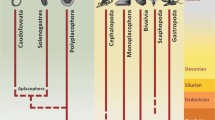Summary
-
1.
The existence of microfibers in the cuticular lamellae of the spider leg (Cupiennius salei Keys.) is demonstrated. Two approaches were taken in the analysis of their architecture: a) An examination of the microfibers of the lamellae and the dependence of their course, as seen in electronmicrographs, on the angle of section through the cuticle, b) A study of the course and shape of the pore canals previously known to have some close relationship to microfiber arrangement.
-
2.
All microfibers run roughly parallel to the cuticle surface; their orientation however gradually rotates through 180° within each lamella. Thus they do not form arches with constant orientation which would lie on planes perpendicular to the cuticle surface.
-
3.
Pore canals form twisted bands. Throughout their length the longitudinal axis of their cross section remains parallel to the direction taken by the microfibers at any given level. In oblique sections through the lamellae the twisting pore canals are cut at different levels. Thus the band sections come to lie at intervals along imaginary arches, much the same as microfiber sections do when the cuticle is cut obliquely. The cutting angle has the same influence on the orientation of the arches formed by pore canal sections as it has on the arches from microfiber sections. In the exocuticle some sections of pore canals cannot be understood in terms of the twisted band concept.
-
4.
Since the lamellae of the tarsus form a cylinder and because the orientation of the microfibers rotates, the microfibers are arranged in coaxial helices of continuously varying pitch.
Zusammenfassung
-
1.
Die Lamellen in der Cuticula des Tarsus der Spinne Cupiennius salei Keys. enthalten elektronenmikroskopisch darstellbare Mikrofasern. Die räumliche Anordnung dieser Mikrofasern wird analysiert; dabei werden zwei Wege beschritten: a) Beurteilung des elektronenmikroskopischen Bildes der Lamelle und dessen Abhängigkeit von der Schnittrichtung durch die Cuticula. b) Analyse der Porenkanalgestalt, von der aufgrund früherer Befunde eine enge Beziehung zur Mikrofaseranordnung zu fordern war.
-
2.
Die Mikrofasern verlaufen sämtlich parallel zur Cuticulaoberfläche, haben jedoch in verschiedenen oberflächenparallelen Ebenen verschiedene Orientierung: Die Richtung ihres Verlaufs rotiert innerhalb einer Lamelle fortschreitend um insgesamt 180°. Sie verlaufen demnach nicht wie Bögen, die auf senkrecht zur Cuticulaoberfläche stehenden Ebenen in Reihen hintereinander liegen.
-
3.
Die Porenkanäle haben die Gestalt von axial in sich verdrehten Bändern mit linsenförmigem Querschnitt, dessen Längsrichtung derjenigen der Mikrofasern folgt. Auf Schrägschnitten durch die Cuticulalamelle werden die Porenkanäle in verschiedener Höhe getroffen; deshalb lassen sich die Anschnitte verschiedener Kanäle auf gedachten Bogen anordnen, die denjenigen der Mikrofasern auf Schrägschnitten durch die Cuticula gleichen. Die Orientierung dieser Bogen ist in derselben Weise von der Schnittrichtung abhängig wie die der Mikrofaserbogen. In der Exocuticula lassen sich nicht alle Porenkanalanschnitte mit der Vorstellung des verdrillten Bandes und dessen Beziehung zur Mikrofaseranordnung vereinbaren.
-
4.
Da die Lamellen des Tarsus Hohlzylinderform haben, sind die Mikrofasern, deren Verlaufsrichtung innerhalb einer Lamelle um 180° rotiert, auf koaxialen Helices variierender Ganghöhe angeordnet.
Similar content being viewed by others
Literatur
Barth, F. G.: Die Feinstruktur des Spinneninteguments. I. Die Cuticula des Laufbeins adulter häutungsferner Tiere (Cupiennius salei Keys.). Z. Zellforsch. 97, 137–159 (1969).
Biedermann, W.: Geformte Sekrete. Z. allg. Physiol. 2, 395–398 (1903).
Bouligand, Y.: Sur une architecture torsadée répandue dans de nombreuses cuticles d'arthropodes. C. R. Acad. Sci. (Paris) 261, 3665–3668 (1965).
—: Sur une disposition fibrillaire torsadée commune à plusieurs structures biologiques. C.R. Acad. Sci. (Paris) 261, 4864–4867 (1965).
—, Soyer, M. O., Puiseux-Dao, S.: La structure fibrillaire et l'orientation des chromosomes chez les Dinoflagellés. Chromosoma (Berl.) 24, 251–287 (1968).
Condoulis, W. V., Locke, M.: The deposition of endocuticle in an insect. J. Insect Physiol. 12, 311–323 (1966).
Drach, P.: Mue et cycle d'intermue chez les crustacés décapodes. Ann. Inst. Océan. Monaco 19, 103–392 (1939).
—: Structure des lamelles cuticulaires chez les crustacés. C.R. Acad. Sci. (Paris) 237, 1772–1774 (1953).
Hass, W.: Die Struktur des Chitins bei Arthropoden. Arch. Anat. u. Physiol. Phys. Abt. 295–338 (1916).
Locke, M.: Pore canals and related structures in insect cuticle. J. biophys. biochem. Cytol. 10, 589–618 (1961).
—: The structure and formation of the integument in insects. In: The physiology of insects (M. Rockstein, ed.), p. 379–470. New York: Academic Press Inc. 1964.
Neville, A. C.: Chitin orientation in cuticle and its control. In: Advances in insect physiology (J. W. L. Beament, J. E. Treherne, and V. B. Wigglesworth, ed.), vol. 4, p. 213–286. London and New York: Academic Press Inc. 1967.
—, Luke, B. M.: Molecular architecture of adult locust cuticle at the electron microscope level. Tissue and Cell 1, 355–366 (1969).
—, Thomas, M. G., Zelazny, B.: Pore canal shape related to molecular architecture of arthropod cuticle. Tissue and Cell 1, 183–200 (1969).
Peters, W.: Vergleichende Untersuchungen der Feinstruktur peritrophischer Membranen von Insekten. Z. Morph. Tiere 64, 21–58 (1969).
Richards, A. G.: The integument of arthropods. Minneapolis: University of Minnesota Press 1951.
—, Korda, F. H.: Studies of arthropod cuticle. II. Electron microscope studies of extracted cuticle. Biol. Bull. 94, 212–235 (1948).
Robinson, C.: Liquid-crystalline structures in polypeptide solutions. Tetrahedron 13, 219–234 (1961).
—: The cholesteric phase in polypeptide solutions and biological structures. Molec. Crystals 1, 467–494 (1966).
Schmidt, E. L.: Die Bausteine des Tierkörpers in polarisiertem Lichte. Bonn: F. Cohen 1924.
Sewell, M. T.: Pore canals in a spider cuticle. Nature (Lond.) 167, 4256, 857–858 (1951).
—: The histology and histochemistry of the cuticle of a spider, Tegenaria domestica L. Ann. ent. Soc. Amer. 48, 3, 107–118 (1955).
Author information
Authors and Affiliations
Additional information
Mit Unterstützung durch die Stiftung Volkswagenwerk.
Rights and permissions
About this article
Cite this article
Barth, F.G. Die Feinstruktur des Spinneninteguments. Z. Zellforsch. 104, 87–106 (1970). https://doi.org/10.1007/BF00340051
Received:
Issue Date:
DOI: https://doi.org/10.1007/BF00340051




